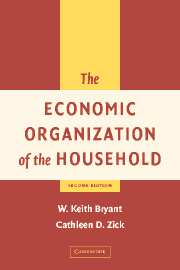Book contents
- Frontmatter
- Contents
- List of Figures
- Preface to the Second Edition
- 1 Introduction
- 2 Household Equilibrium
- 3 The Analysis of Consumer Demand
- 4 Consumption and Saving
- 5 Work and Leisure : How the Household Spends Its Time
- 6 Human Capital : Investing in Oneself and One's Family
- 7 The Economics of Fertility
- 8 The Economics of Marriage and Divorce
- References
- Index
7 - The Economics of Fertility
Published online by Cambridge University Press: 06 July 2010
- Frontmatter
- Contents
- List of Figures
- Preface to the Second Edition
- 1 Introduction
- 2 Household Equilibrium
- 3 The Analysis of Consumer Demand
- 4 Consumption and Saving
- 5 Work and Leisure : How the Household Spends Its Time
- 6 Human Capital : Investing in Oneself and One's Family
- 7 The Economics of Fertility
- 8 The Economics of Marriage and Divorce
- References
- Index
Summary
INTRODUCTION
In the United States the birthrate has fallen over the past 185 years from about 55.2 births per 1000 population in 1820 to 32.2 in 1900, and 13.9 in 2002. Over the long run and with the exception of the post–World War II baby boom, Americans have been having fewer children.
The post–World War II baby boom followed by the baby bust of the 1960s and 1970s is the major exception to the long-run trend. Total fertility rates from 1940 to the present tell this tale. The total fertility rate is a better measure of the fertility experience of women than the birthrate because “the total fertility rate is the number of births that 1000 women would have in their lifetime if at each year of age, they experienced the birth rates occurring in the specified year” (U.S. Bureau of the Census 1999). In 1940–1944 the total fertility rate was 2523 per 1000 women. It peaked in the 1955–1959 period with 3690 births per 1000 women, after which total fertility rates started to fall. In the 1975–1979 period the total fertility rate was 1810 per 1000 women. After reaching a low of 1738 births per 1000 women in 1976, it has increased to 2115 in 2001. Over this period the replacement rate (i.e., the birthrate necessary to sustain a constant population in the absence of net immigration) has been 2110 births per 1000 women.
- Type
- Chapter
- Information
- The Economic Organization of the Household , pp. 236 - 261Publisher: Cambridge University PressPrint publication year: 2005

